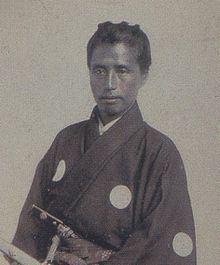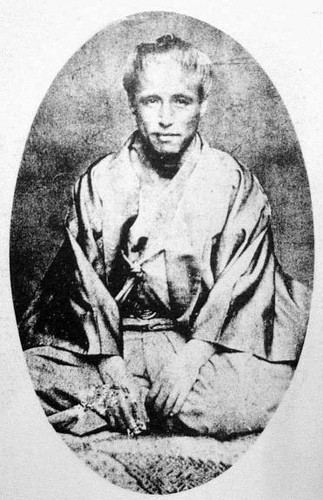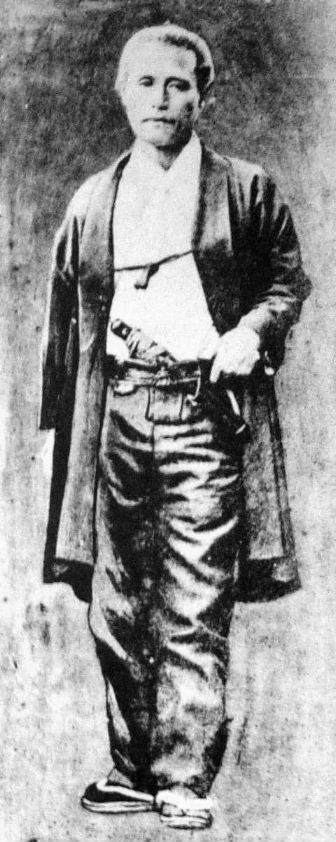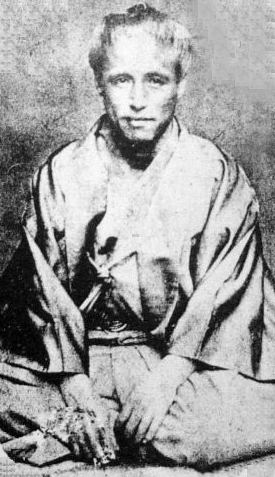Nickname(s) Awa Katsu Name Katsu Kaishu Parents Katsu Kokichi | Rank Naval officer Other work military theorist Role Statesman | |
 | ||
Years of service 1855-1868 (Tokugawa);1872-1899(Imperial Japan) Commands held Kanrin-maru (warship)Kobe Naval SchoolVice MinisterNaval Lord (海軍卿) Similar People Saigo Takamori, Sakamoto Ryoma, Tokugawa Yoshinobu, Yamaoka Tesshu, Kido Takayoshi | ||
Count Katsu Kaishū (勝 海舟, March 12, 1823 – January 21, 1899) was a Japanese statesman and naval engineer during the late Tokugawa shogunate and early Meiji period. Kaishū was a nickname which he took from a piece of calligraphy (Kaishū Shooku 海舟書屋) by Sakuma Shōzan. He went through a series of given names throughout his life; his childhood name was Rintarō (麟太郎) and his real name was Yoshikuni (義邦). He was often called Awa (安房) from his title Awano-kami (安房守) during the late Tokugawa shogunate and changed his name to Yasuyoshi (安芳) after the Meiji Restoration.
Contents

Katsu Kaishū eventually rose to occupy the position of commissioner (Gunkan-bugyō) in the Tokugawa navy. He is particularly known for his role in the surrender of Edo.

Early life

Katsu was born in Edo (present day Tokyo) to a low-ranking retainer of the Tokugawa Shogun. His father, Katsu Kokichi, the subject of the autobiography, Musui's Story, was the ill-behaved head of a minor samurai family. As a youth Katsu Kaishu, whose given name was Katsu Rintaro (Kaishu was pseudonym), studied Dutch and European military science, and was eventually appointed translator by the government when European powers attempted to open contact with Japan. Katsu developed the reputation as an expert in western military technology.

Under the advice of Dutch naval officers, Katsu served as head naval cadet at the Nagasaki Naval Academy between 1855 and 1859.
Military service
In 1860, Katsu served as captain of the warship Kanrin-maru, (with assistance from US naval officer Lt. John M. Brooke), to escort the first Japanese delegation to San Francisco, California, en route to Washington, DC, for the formal ratification of the Harris Treaty. The Kanrin Maru, built by the Dutch, was the first Japanese vessel to sail to the Western world. Kaishū remained in San Francisco for nearly two months, observing American society, culture and technology. Following his return to Japan, Katsu held a series of high-ranking posts in the Tokugawa navy, arguing before government councils in favor of a unified Japanese naval force led by professionally trained officers in disregard of promotion and assignment due to hereditary status. During his command as director of the Kobe Naval School, the institute would become a major source of activity for progressive thinking and reformists between 1863 and 1864.
In 1866, Katsu was appointed negotiator between the bakufu forces and the anti-shogunal domain of Chōshū, and later served as chief negotiator for the Tokugawa bakufu, ensuring a relatively peaceful and orderly transition of power in the Meiji Restoration.
Although sympathetic to the anti-Tokugawa cause, Katsu remained loyal to the Tokugawa bakufu during the Boshin War. After the collapse of the Tokugawa forces in late 1867, Katsu negotiated the surrender of Edo castle to Saigō Takamori on 11 April 1868.
Later years
Katsu relocated to Shizuoka after the new Imperial government took control of the shogun's former capital, which was renamed Tokyo ("Eastern Capital"). He returned briefly to government service as Vice Minister of the Imperial Japanese Navy in 1872, followed by first Minister of the Navy from 1873 until 1878. He was the most prominent of the former Tokugawa retainers who found employment within the new Meiji government, and was sangi (参議) between 1869 and 1885 who did not come from one of the four paramount domains. Although his influence within the navy was minimal, as the Navy was largely dominated by a core of Satsuma officers, Katsu served in a senior advisory capacity on national policy. During the next two decades, Katsu served on the Privy Council and wrote extensively on naval issues before his death in 1899.
In 1887, he was elevated to the title of hakushaku (count) in the kazoku peerage system.
Katsu recorded his memoirs in the book Hikawa Seiwa.
Honours
Translated from the corresponding article in the Japanese Wikipedia
